how to fix hail damage
In 2020, the United States experienced 4,611 large hail storms, as documented by the NOAA Severe Weather Database.
One of the 2019 storm clusters was a beast of a hail storm in Colorado.
That storm dropped a record-setting 4.83-inch diameter hailstone in Bethune, Colorado.
Every year, multiple hail storms cause billions of dollars of property damage.
Many of these storms included baseball-sized hail or bigger.
But.
What we'll discover in this article.
Is that even much smaller sized hail… can and does cause roof hail damage.
Many homeowners are not aware ofhail damage on their roofs. Hail damage to roof tops often times cannot be seen from the ground, and that's a big reason why the idea of hail damage hardly ever crosses a homeowner's mind.
Today we will show you EXACTLY what to look for when inspecting a home for roof hail damage.
We're going to answer questions like…
- What are some signs that hail damage has occurred at a house (even before stepping foot on the roof)?
- What are some of the signs of hail damage on a roof?
- What does hail damage look like on shingles?
- What size hail causes roof damage?
You will also learn how to identify and mark out hail damage for insurance claims.
(View Roof Hail Damage Pictures)
 As always… practicesafety first.
As always… practicesafety first.
Before inspecting a roof, make sure you have a good pair of soft-soled shoes or roofing boots. Always check that your ladder is in perfect working condition, and bring a few sticks of chalk to help mark any hail damage you might see.
And, of course, don't forget your camera.
If you are a homeowner…
You will also learn how to tell if you have hail damage on your roof and what to do.
Homeowners: Inspecting a roof can be dangerous. It's very important that you have all of the proper safety gear and knowledge. Many contractors offer a free roof inspection, so please don't hesitate to contact a professional before jumping up on your own roof.
First – What is Hail and How Does it Form?
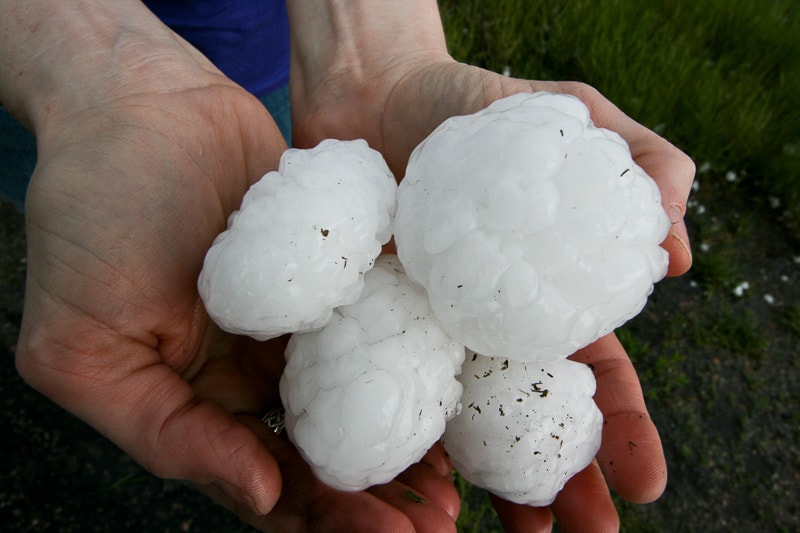
Hail is a type of precipitation that occurs when air updrafts (upward air currents) in thunderstorms carry raindrops into the upper level clouds where temperatures are below freezing. A small particle of ice forms around some type of nucleus. It could be a tiny ice crystal, spec of dust, frozen raindrop or something else.
The frozen ice particle then drops within the cloud back below freezing temperatures, where it picks up more moisture from rain drops and water vapor. Eventually it gets caught in another updraft and freezes again.
The stronger the updrafts, the longer a hailstone circulates up and down… growing larger and larger until gravity no longer allows it to remain lofted.
At that point, the hail falls toward the ground, where it can inflict damage on people or property.
Tell-Tale Signs Of Hail Damage on a Roof
Although you cannot fully determine the amount of hail damage on a roof from the ground, there are some signs that a trained eye can point out and help determine if there may be more damage up top.
The presence of one or more of these may indicate a situation where the homeowner needs a full roof replacement instead of a simple roof repair. Here are a few things to look for.
ONE – look for dented gutters, gutter screens, or downspouts
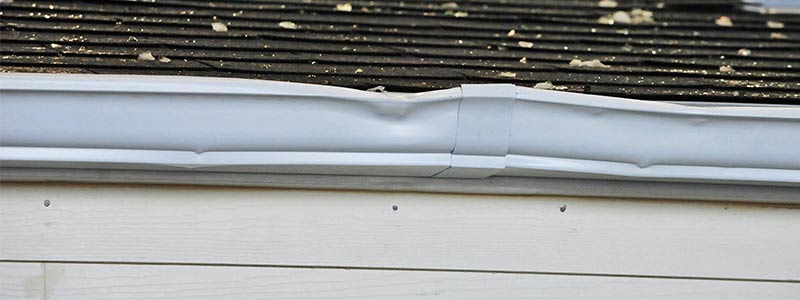
This is not always the case, but many times, if a roof has significant hail damage up top, the gutters will have some impact damage. This above picture shows a heavily dented gutter, but be on lookout for small impacts as well.
TWO – look for damage to siding and windowsills/casings
You can also check the home's siding and windowsills/casings for dents, dings or other signs of impact. These are places where, if there's significant damage to the roof, there will most likely be damage to these things as well.
Look also at any other exposed metal surfaces, like metal fascia on the roof eaves for signs of hail damage impact, even if it looks like a faint ding.
THREE – look for damage to air conditioners or other outdoor items
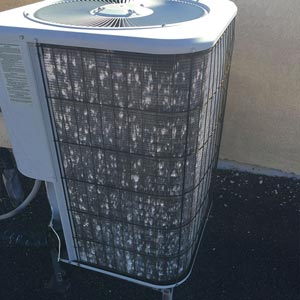 As we've discussed, it's important to check every area of the home for hail damage. We've done the roof, gutters and siding, but there's another area to check… the air conditioner.
As we've discussed, it's important to check every area of the home for hail damage. We've done the roof, gutters and siding, but there's another area to check… the air conditioner.
In addition to offering a quick glance sign of further hail damage on the roof, a damaged air conditioner may qualify for insurance replacement.
As an inspector, it's your job to make sure you make note of everything that was damaged on the homeowners property. This could be a shed, patio cover, porch, decking, anything that the insurance may cover.
FOUR– look for damage to decks or painted wood surfaces
Decks and other painted surfaces surrounding the home may have sustained hail damage. If you see chipped paint, it may be the result of hail impact. For more tell-tale signs of hail damage, check out this big checklist of items that point to roof hail damage.
Now… Let's get on the roof.
Hail Damage To Roof Vents And Shingles
Once you're up on the roof, there's going to be a few things to look for. Vents, chimneys, sky lights, other features and shingles are on our inspection list.
Hail damage often accompanies wind damage to roofing systems, so you'll want to look for both.
Check out all the roof vents and features to look for any damage. Look for dents, dings, chipped surfaces, etc.
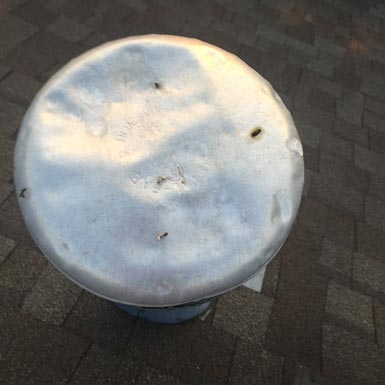
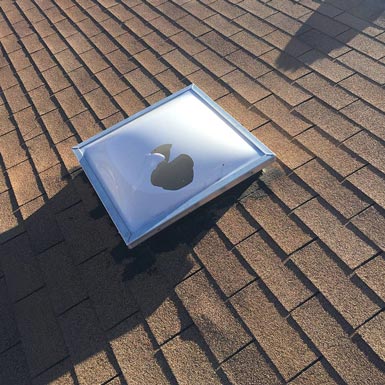
For the harder to see impact areas like the chimney covers (below), run your chalk sideways over the surface and it will uncover the hail impact points. For the softer metal vents, the damage will be much more obvious.

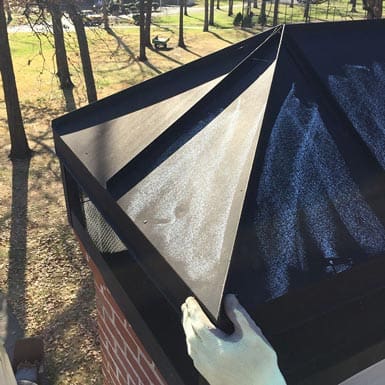
The last, but most important thing to check is theshingles. Hail damage to roof shingles are what buys the roof. You'll never get a solid insurance claim without shingle damage.
What does hail damage look like on shingles?
Hail damage to roof shingles can be very obvious or very difficult to uncover. It takes a trained eye to spot hail damage to roof shingles.
As you can see on the first image below, the surface granules have been knocked off of the shingle very clearly.
The rest of the pictures make it much harder to notice that the shingle has sustained hail damage.
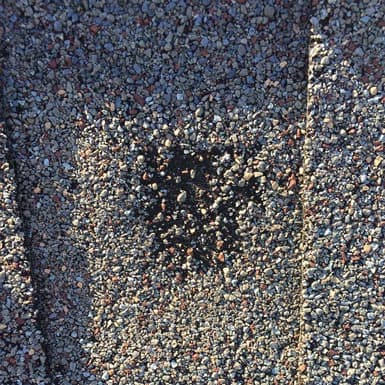
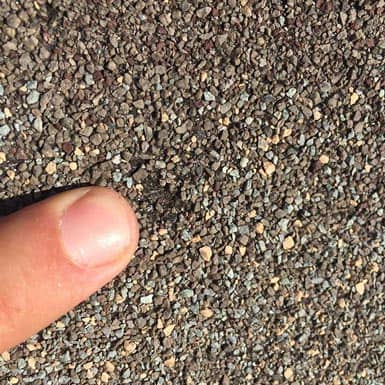
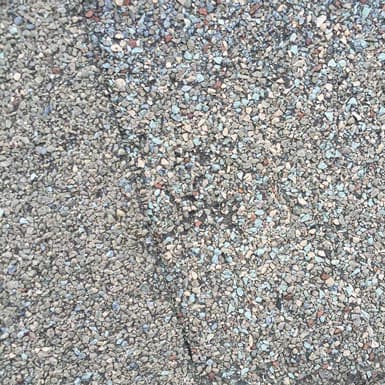
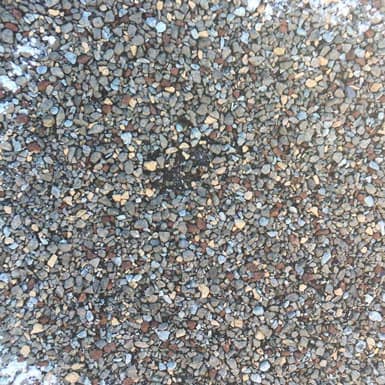
View more pictures of roof hail damage
What's the big deal if a few granules come loose?? There's not a hole in the roof!
You may be surprised at the force it takes knock the surface materials off of a shingle. When this is discovered, the integrity of the shingle has been compromised, and a water leak can develop over time. Even the smallest hail impact on a shingle can lead to a roof leak.
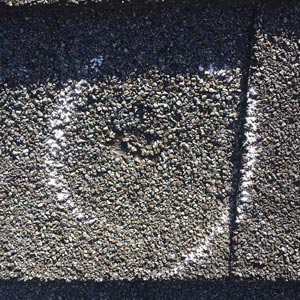 Now it's your job to determine if there's enough information here to make an insurance claim. Most insurance companies want to see 8+ hits on the roof within a 10ft x 10ft square on at least 3 sides of the roof.
Now it's your job to determine if there's enough information here to make an insurance claim. Most insurance companies want to see 8+ hits on the roof within a 10ft x 10ft square on at least 3 sides of the roof.
Mark each hit with chalk so you can accurately determine if there is enough damage to have the homeowner make a claim.
Take pictures of the hail hits to show the homeowner whenever you're done inspecting the roof. You can also show these pictures to the insurance adjuster whenever they come out for their inspection of the roof.
Now, you should have enough information to determine whether or not the home owner will need a roof replacement.
Metal Roof Hail Damage
Shingles can be tricky when it comes to spotting hail damage, but they're not the only type of roof out there. You have others like wooden shake, clay, slate and metal roofing.
Wood shingles will split right down the middle after being struck by hail. Clay & slate roofing will have cracks and/or gouges, and metal roofing will have impact dents like we saw on the gutters at the beginning.
Metal roofing is one of the easiest to spot for hail damage.
Here are some examples of hail damage on a metal roof.
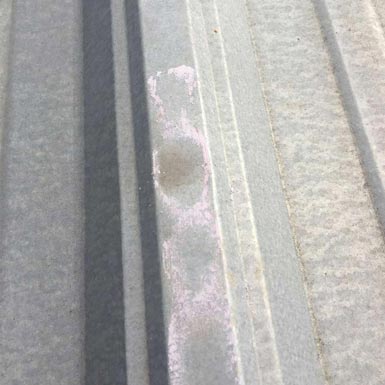
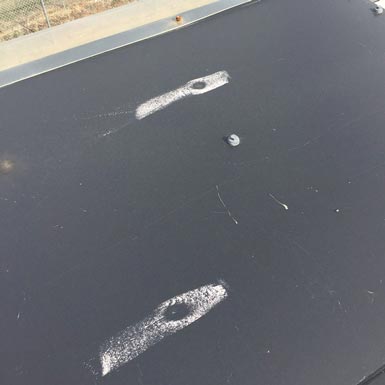
See all hail damage pictures here.
What About Hail Spatter
Hail spatter – sometimes called hail splatter – results when "slushy" type hail leaves discolored marks or stains on your roof or appliances like AC units.
Spatter is evidence of hail on the property and it can be used to determine the size and direction of the hail, but the spatter marks themselves usually do not result in claimable damage.
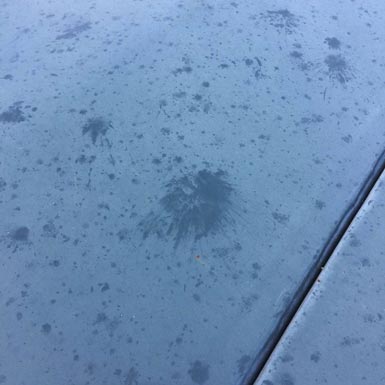
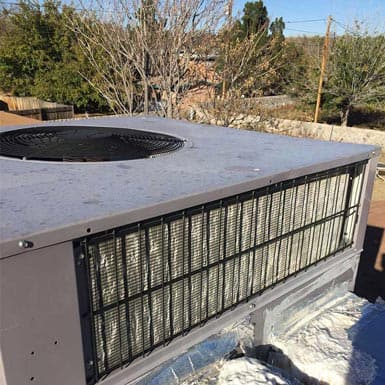
What size hail causes roof damage?
On average, it takes a 1″ or above diameter hail stone to cause damage to common asphalt shingles. When referring to hail sizes, here are a few common objects to compare:
- Pea = 1/4-inch in diameter
- Marble = 1/2-inch in diameter
- Dime or penny = 3/4-inch in diameter (hail the size of a penny or larger is considered severe)
- Nickel = 7/8-inch
- Quarter = 1 inch
- Golf Ball = 1½ inches
- Tennis Ball = 2½ inches
- Baseball = 2¾ inches
- Tea cup = 3 inches
- Softball = 4 inches
Several surveys and studies have been completed to show to damage potential of different size hail stones on various types of common roofing materials. Field observations and ice stone impact tests provide some common correlation between stone size and damage potential.
| Material | Hailstone Size |
|---|---|
| 3-Tab organic asphalt shingles | 1″ |
| 3-Tab fiberglass asphalt shingles | 1¼" |
| Cedar shingles | 1¼" |
| Fiber-cement tiles | 1¼" |
| Flat concrete tiles | 1¼" |
| Heavy cedar shakes | 1½" |
| 30-year laminated shingles | 1½" |
| Built-up gravel roofing | 2″ |
| S-shaped concrete tiles | 2″ |
What does hail damage do to a roof?
The severity of hail damage to a roof depends on several factors, including:
Type of roofing materials, age of roofing materials, roof slope, quality of construction…
…as well as hail size, hail density, and hail shape and the velocity and angle of its fall.
Hail damage can also be affected by the number of shingle layers on a roof. Second layer shingles are more susceptible to damage than first layer shingles, because the surface directly underlying the shingle is less supportive than dense wood.
Hail damage can either be 'functional' or 'cosmetic' in nature.
Functional hail damage refers to damage that affects the integrity and longevity of the roof. Cosmetic hail damage refers to damage that does not affect the viability of the roof to perform its function.
In 2013, the American Association of Insurance Services, introduced a "Cosmetic Damage Exclusion" to allow insurers to avoid coverage for cosmetic damage. However, sometimes, a roof that has been functionally damaged will be passed off as only cosmetically damaged by the insurance company.
A qualified, trained roof inspector will know the difference and can assist the homeowner to make sure the insurance designation is properly assigned.
INTERESTING FACT: Baseball size hail stones fall at nearly 100 miles per hour.
Wood shake, clay, concrete and other dense roofing material types can be instantly cracked or shattered by large hail stones.
Hail damage to asphalt shingles may consist of punctures, tears, fractures (bruises) or the more common displacement of granules.
Displacement of granules occurs when granules have been knocked off by the impact of hail stones hitting the roof. The loss of protective granules exposes underlying asphalt to damaging sun rays.
When asphalt is directly exposed to the sun, without a protective layer of granules, the shingle becomes vulnerable to UV light degradation.
Which can accelerate cracking, blistering, algae formation, edge damage, and water leaks.
What do I do If I think I have hail damage?
If you're a homeowner and think you may have hail damage, the first thing you should do is call a professional contractor for a free roof inspection.
If the inspector thinks you may have damage, your next step would be to file an insurance claim with your homeowners insurance company. Your insurance adjuster will put together an Xactimate estimate.
A lot of people ask: "Will insurance pay for a new roof?" This depends on your policy and who you have on your team. A trained professional can determine whether the damage is functional or cosmetic in nature. A public adjuster can help you negotiate a fair deal with the adjuster.
Homeowners: It's very important that you have your contractor come out and inspect the roof with your insurance adjuster. You have to remember the insurance company is looking for reasons NOT to replace your roof. That's why it's important to make sure your contractor inspects the roof with the adjuster.
In Summary…
Hail damage inspections are vital skills for professionals working in roofing sales and project management. Equipped with the right information and resources, you'll have a trained eye to spot hail damage for homeowners and commercial companies and help them get fair coverage for the losses they've sustained.
Make sure to ask the homeowner if they have been experiencing any leaks in the home that could have resulted from the hail damage to roof shingles. Our job is to assist the homeowner to get full and fair settlement for all parts of the home that have sustained damage as a result of hail or wind.
Now it's Your Turn
I'd like to hear what you have to say:
Maybe you have a hail damage story you'd like to share.
Or maybe you have some additional tips to help our readers.
Or maybe you have a question.
Either way, let me know by leaving a comment below right now.
how to fix hail damage
Source: https://www.restoremastersllc.com/hail-damage-roof/
Posted by: velozbeted1955.blogspot.com

0 Response to "how to fix hail damage"
Post a Comment